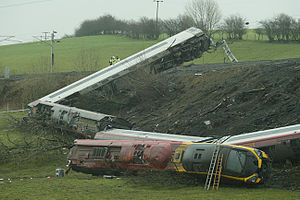Grayrigg rail crash

The scene of the accident
|
|
| Date | 23 February 2007 |
|---|---|
| Time | 20:15 GMT |
| Location | Grayrigg, Cumbria |
| Coordinates | 54°21′25″N 2°39′36″W / 54.357°N 2.660°WCoordinates: 54°21′25″N 2°39′36″W / 54.357°N 2.660°W |
| Country | England |
| Rail line | West Coast Main Line |
| Operator | Virgin Trains |
| Cause | Defective points due to poor maintenance and inspection procedures. |
| Statistics | |
| Trains | 1 |
| Passengers | 105 + 4 crew |
| Deaths | 1 |
| Injuries | 30 serious, 58 minor |
| List of UK rail accidents by year | |
The Grayrigg derailment was a fatal railway accident that occurred at approximately 20:15 GMT on 23 February 2007, just to the south of Grayrigg, Cumbria, in the North West England region of the United Kingdom. The accident investigation concluded that the derailment was caused by a faulty set of points (number 2B) on the Down Main running line, controlled from Lambrigg ground frame. The scheduled inspection on 18 February 2007 had not taken place and the faults had gone undetected.
Although the accident killed far fewer people than some other accidents on the West Coast Main Line, it had a major negative impact on Network Rail's safety record.
The 17:30 Virgin West Coast Pendolino West Coast Main Line InterCity service from London Euston to Glasgow Central derailed at 20:15 at a faulty set of points almost immediately after crossing the Docker Viaduct (the rear half of the train would still have been crossing the bridge whilst the front derailed at the points). The train was reported to have been travelling at 153 km/h (95 mph) when it was derailed. The train consisted of unit 390033 'City of Glasgow', which was constructed at Washwood Heath, Birmingham, in 2002, and consisted of nine carriages. It carried 105 passengers and four crew.
Passengers said that the carriages of the train began rocking and swaying violently before the train left the rails and careered down an embankment, with the first carriages jack-knifing and most of the train coming to rest in a field. The train was reported as being evacuated around midnight. Emergency crews scanned the train with thermal imagery equipment to make sure there was no one still inside. Up to 500 rescuers attended the scene, along with at least 12 ambulances, at least five fire engines, three Royal Air Force Sea King search and rescue helicopters, the International Rescue Corps, three civilian mountain rescue teams plus RAF Leeming Mountain Rescue Team, and one Merseyside Police helicopter. The rescue operation was hindered by rain, darkness, and access problems caused by the narrow country lanes and muddy fields. Emergency vehicles experienced difficult conditions, needing to be towed by farm vehicles or tractors after becoming bogged down in mud. The train's derailment caused severe damage to the Overhead Line Equipment and tripped the entire circuit between Brock (near Preston) and Tebay resulting in a number of other electric-powered services coming to a halt and all signalling equipment immediately turning to danger (red) in accordance with the system's fail safe design.
...
Wikipedia
